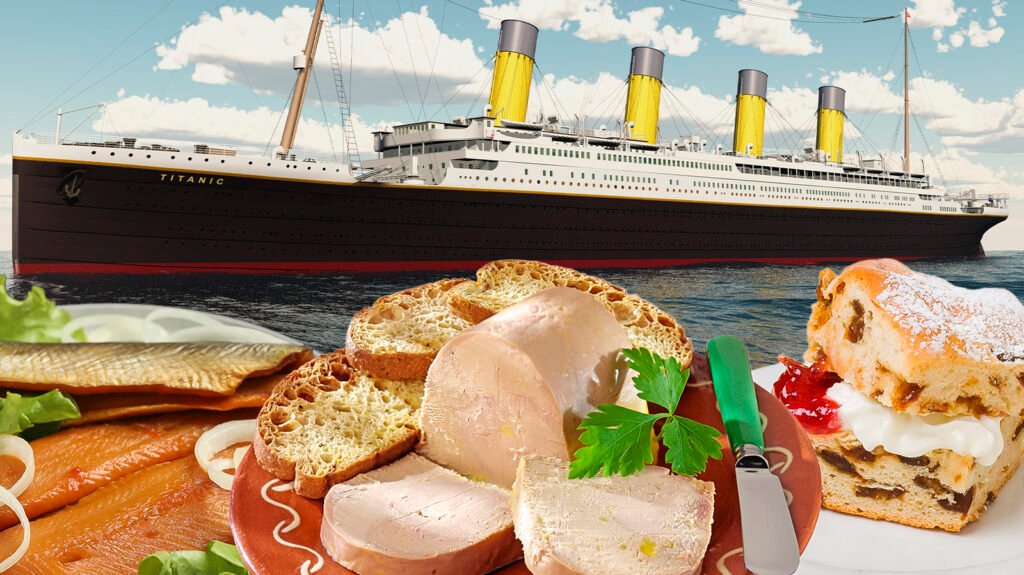At the time of its maiden voyage in 1912 — and subsequent sinking — the R.M.S. Titanic had been one of the most opulent ships to sail as well as the largest. Fanciness was the point of the Titanic, as the team at White Star — the company that commissioned the building of the Titanic — wanted to hold a fleet of comfort-forward ships. To make that fleet a reality, they also built two sister ships to the Titanic, the R.M.S Olympic (which sailed first in 1911) and the H.M.H.S Britannic, which have their own stories. The Titanic and its sister ships set a new standard for transatlantic travel, which had been a historically difficult and uncomfortable journey beforehand. Even the third class sections of the ship offered better amenities than others.
Curiosity around what life was like on the ship have only been further spurred by films like James Cameron’s “Titanic,” and the truth varies depending on what class a passenger was in. Those in first class were, as expected, wealthy individuals who could afford the ticket and ate meals according to their status. Many in second and third class had no fame to speak of, and their accommodations and food only went as far as the amount of money they spent on their tickets. So what exactly did people eat on the Titanic during its days of travel before disaster struck? We’re diving into 14 meals and foods eaten by passengers from first to third class.
Mallard Duck
As to be expected, there was a marked difference in the foods that first class and third class passengers on the Titanic ate. For the first class passengers, decadence and opulence was to be expected at every meal. Plenty of organic items from the Titanic wreckage have actually been recovered, including a dinner menu from April 11, a mere four days before sinking. One meal on the docket was mallard duck with port wine sauce.
Mallards are a specific species of duck found abundantly in the Northern Hemisphere, thought to be the ancestor for many modern domesticated duck species. They’re said to have a rich and savory flavor tinged with a bit of gameiness that can be masked in a brine or marinade. Though not all that different to break down, duck (when raised and not hunted) are more expensive to produce than chicken. Fine dining restaurants often served it as a protein option, likely pushing the meat into the luxury category.
Victoria Pudding
Likely named after Queen Victoria who reigned in England from 1837 to 1901, Victoria Pudding was served to first class passengers on the Titanic, as well as second class passengers on the R.M.S. Lusitania, which had its own sinking disaster. While there’s no surefire way to know exactly which Victoria Pudding was served to Titanic first class passengers, some assume it to have been a custard based dessert, unlike some of the sponge based recipes of the same name.
The dish is heavy on the banana flavor, as the recipe calls for at least six bananas that are puréed alongside vanilla custard. Orange and lemon pulp, as well as pineapple, is added to the mix with sugar. Liquids like brandy and orange-flower water are added, mixed, and then frozen in a mold. The final touch comes in the presentation, which features a compote made of bananas, apricot jam, maraschino cherry syrup, citrus juice, and sliced bananas.
Spring Lamb
Lamb has been eaten across continents for thousands of years as one of the first domesticated animals, even having religious significance in the Christian and Jewish faiths. Most lambs are born in the spring, though the months are dependent on numerous factors like weather, breed of sheep, and how the flock is raised. As such, the term “spring lamb” is used for those lambs that are slaughtered and butchered between three to five months old.
Since spring lambs are small — yielding less than 50 pounds of meat — the cost is typically higher and thus seen as more luxurious. On the Titanic, the spring lamb was likely roasted with a marinade of garlic, oil, mustard, and rosemary. Mint sauce is a customary accompaniment for lamb and has varying recipes. One simple recipe features four ingredients: mint, sugar, water, and white wine vinegar. Where the mint sauce is fresh and sweet, the lamb is rich and gamey and the pairing melds acidity and fattiness for a contrasting balance.
Chicken à la Maryland
On April 14, the day the Titanic sank, first class diners had a robust lunch menu to choose from. One such dish? Chicken à la Maryland. In short, chicken à la Maryland is a version of fried chicken, which was actually eaten only for special occasions in the United States prior to World War II. This was because it made more economic sense to keep a chicken alive for its eggs than slaughter it for a meal or two, at most. While fried chicken has a long history around the world, many in the American South have laid claim to the title of best fried chicken, lauding original recipes created by enslaved African Americans.
Commercial farming for chickens ramped up in the years following the Titanic’s sinking, so it was still considered a rather fancy — and expensive — dish. Recipes for the dish vary, but as with most fried chicken recipes, there are some basic tenants. The chicken should be dredged in flour (seasoned, of course) and then pan-fried in a cast iron pan. Any leftover drippings or grease is then turned into a gravy that’s used to top the dish. Some recipes call for a banana garnish, while others opt for mashed potatoes or some other vegetable.
Pâté de Foie Gras
Foie gras is fatty liver from ducks or geese. It’s a food produced through the force-feeding of grain and fat to male ducks or geese through a tube inserted into their esophagus, which, among other side effects, causes the animal’s liver to grow well beyond its normal size. Foie gras is thought to have been first enjoyed by ancient Egyptians, who ate the fatty livers of geese after the animals had eaten more than normal pre-migration. Geese were domesticated and, from Egypt, the practice of domestication and excess feeding for foie gras purposes spread.
After the liver is fattened, the animal is slaughtered, the liver is removed, and then prepared into foie gras. On the Titanic, foie gras was served as a pâté, which means it was turned into a spread with a paste-like consistency as opposed to served whole. Today, many find the means of force-feeding to be cruel and New York City even attempted to ban the sale of foie gras within the city limit, though it was overturned by the New York Supreme Court. On a positive note, science has potentially offered a new option for creating liver fattiness without extra feeding to maintain the taste for consumers and lessen the stress on the animals.
Mutton Chops
In the United States, lamb and sheep aren’t the most popular animal protein sources (that would be chicken), but there are plenty of recipes that call for sheep with historical importance. Take, for instance, mutton chop. It’s not a cut of meat so much as a qualification determined by the age of the sheep when it was slaughtered. Mature sheep, or any sheep over a year old (but more likely two to three years old), was eaten across the globe, especially in the United Kingdom during the Victorian era.
Thanks to the maturity of the animal prior to slaughter, mutton has a stronger flavor than that of a spring lamb. The gamey flavor is greater, again due to age, and has a tougher texture due to the musculature of the mature animal. It was a popular dish prior to World War II, but soldiers were reportedly fed canned mutton while overseas. Given foods intricate ties to memory, it seems many chose to move away from the meat following the war.
Sultana Scones
Let’s talk about scones, which have been eaten in the United Kingdom since at least the 16th century after originating in Scotland. The original scone wasn’t made with flour and baked in an oven, but rather was made of oats then baked over an open flame. It wasn’t until the 1840s when the Duchess of Bedford created afternoon tea due to getting hungry between lunch and dinner that scones were introduced to daily routine for the masses.
On the Titanic, sultana scones were served to the first class during breakfast. The name sultana comes from the Sultana grape, which were originally found in the area once known as the Ottoman Empire. Sultanas have a more complex flavor profile than regular raisins, but use the same drying process. In scones, they add a bit of juiciness to the slightly moist interior and provide an additional texture alongside the crumbly, flaky exterior.
Buckwheat Cakes
Buckwheat is thought to have been first cultivated in Asia upwards of 8,000 years ago. The buckwheat name can cause some confusion, as it isn’t at all related to wheat. Instead, it’s a seed used in similar ways to cereal grains, like wheat, oats, barley, and corn. The groats of the buckwheat plant — that is, the hulled seeds — can be ground into flour for pancakes and crepes or noodles (like that of the Japanese soba noodle). On top of its versatility, buckwheat is also naturally gluten free, which makes it a perfect option for those who have Celiac disease or other gluten sensitivities.
Buckwheat cake is merely another term for a pancake made from buckwheat flour. Due to the composition of buckwheat, the resulting cakes have a grayer color and can be grittier in texture. The flavor leans more towards the nutty, earthy side, and because it doesn’t have gluten, the resulting cakes can be denser. Most buckwheat cakes can be served with anything suited for a typical pancake like maple syrup, compotes, and jams, alongside savory toppings of fish or other meat.
American Ice Cream
The roots of ice cream can be dated back to ancient civilizations in the Middle East and Asia that made water-based frozen, sweet mixtures, but our modern interpretations of milk-based ice cream emerged in the 17th century. Second class passengers on the Titanic were served “American ice cream,” and for those who are unfamiliar, that may be a strange classification. In the history of ice cream, there are endless recipes and types, and Americans have a distinguished version. Italian gelato and French ice cream, for example, use varying types of dairy and amount of eggs.
American ice cream prioritizes the use of heavy cream with a higher fat content and may include eggs, but doesn’t always (whereas custard always has eggs). It’s difficult to say what flavors of ice cream were served aboard the Titanic but it could easily have been Neapolitan, which was considered one of the most popular flavors of the preceding decade.
Grilled Ox Kidneys
Organ meat has always been an incredible source for bioavailable nutrients like vitamins A, D, E, and K and minerals. Back when individuals processed their own animals, whole animal utilization was a big deal because it helped a hunt last a great deal longer, especially when tools for hunting weren’t nearly as sophisticated as they are today. As industrialization happened and animals became factory-farmed (or at least farmed on a larger scale for quicker product turnaround), whole animal utilization lost popularity. Not only that, but as muscle cuts of animals became the preferred standard, organ meat in the United States was often seen as lower class.
When it comes to ox in particular — the kidney meat of which was served to second class passengers on the Titanic — the definition of what exactly an ox is can be confusing. Essentially, it’s a muscular male bovine that has been castrated. The taste of bovine kidney is said to be earthy and metallic with a denser texture than other cuts of meat. Grilled, it likely had a charred, smoky flavor and was served alongside bacon to passengers.
Waldorf Pudding
The exact recipe used to make the Waldorf pudding that was served to passengers on the Titanic is thought to have been lost in the sinking, but recipe lovers over time have united in creating variations that harken back to the British cooking tradition of puddings. Puddings are integral to British cuisine and have two meanings. “Pudding” can mean dessert or it can specifically mean a dish that’s steamed or boiled in some form of a container. For example, black pudding is a savory dish traditionally cooked in tripe skin while figgy pudding is a sweet steamed dessert.
Waldorf pudding is thought to have been sweet, filled with apples, raisins and lemon juice and cooked in a custard. It was one of the desserts served on the final night of the Titanic’s journeyand believed to have been served for the individual, so ramekins were likely the serving dish.
Gruel
Different forms of porridge have been eaten by many civilizations given the versatility and affordability of oats and other grains like it — think Quaker Oats in the United States or burbara in the Middle East. The term “gruel” is given to a thin consistency porridge made by boiling oatmeal or another grain in either water or milk. It’s a simple meal requiring very little ingredients which made it popular to serve to employees in workhouses during Victorian England. The more watery the porridge, the more mouths a pot could feed.
It’s no surprise then that gruel was served to third class passengers aboard the Titanic — but just because people were in third class didn’t mean their trip was cheap. Accounting for inflation, a third class ticket today would cost upwards of $1,000. Approximately 1,500 people of the 2,200 on board perished in the sinking with around 75% of third class passengers not having survived.
Smoked Herrings
Herring has long been eaten as a source of cheap protein. Omega 3 fatty acids and are found plentifully in the North Atlantic and Baltic regions of the ocean, as well as the Pacific Ocean. Whether found in the Atlantic or Pacific, herrings are small-headed, slab-sided fish. As a species, they’re incredibly abundant with female herrings producing anywhere from 30,000 to 200,000 eggs. Scandinavians have long eaten herring, particularly through the pickling method, which made it easier to move fish without the food going bad.
In the United Kingdom, kippers is a popular breakfast dish. The dish is made of herring that is made using the process of kippering, which is to open and clean the fish then salt and smoke it. Due to the availability and affordability of herrings, smoked herring was offered to third class passengers, but fresh herring were on the menu for the first class passengers.
Narbonne Honey
It’s difficult to overstate the importance of honey in human history. Before beekeeping for honey, ancient humans foraged for wild honey from hives, as depicted in a cave painting found in Valencia, Spain, — it shows a man climbing a tree towards a beehive. All sorts of uses can be found for honey, such as for wound care and healing by the Egyptians and Greeks, among other ancient civilizations. Today, honey is still used for its antibacterial and anti-inflammatory properties with research suggesting it can reduce heart disease risks and alleviate gastrointestinal issues.
What makes Narbonne honey special is the location that it comes from. The city of Narbonne in France has a countryside full of wild herbs. Since honey is the result of a bees collection of nectar from plants, the resulting honey has a floral, herby taste (leaning heavily on subtle rosemary flavors) and creamy texture. Due to the demand for the honey, it was costly to stock, making it quite the decadence on board the Titanic for breakfast.



